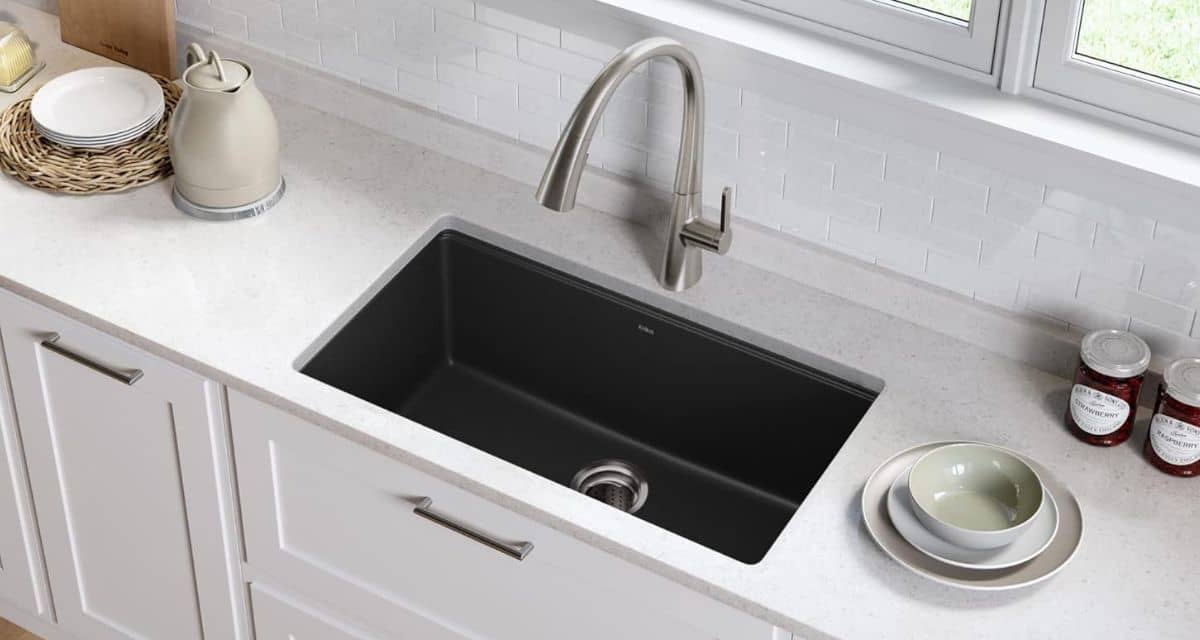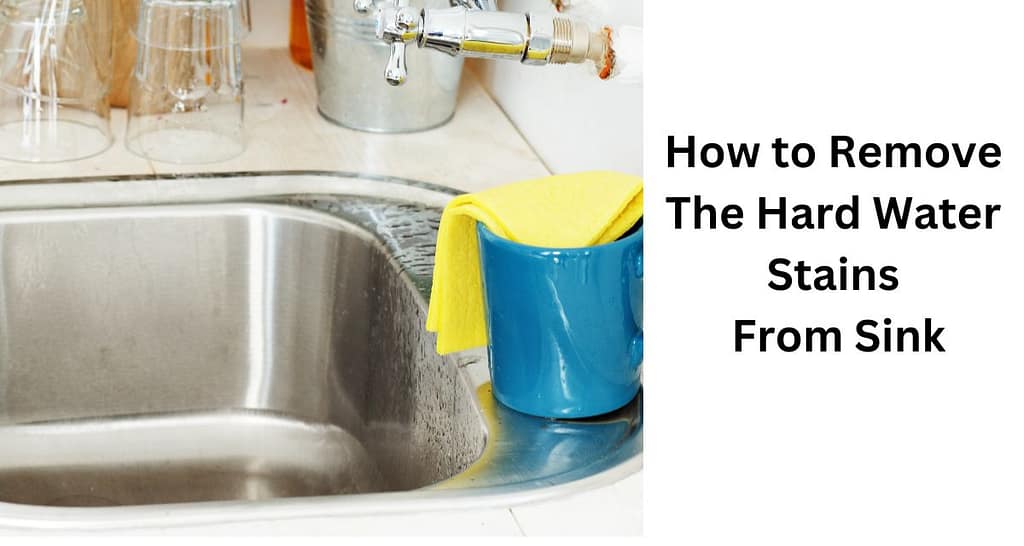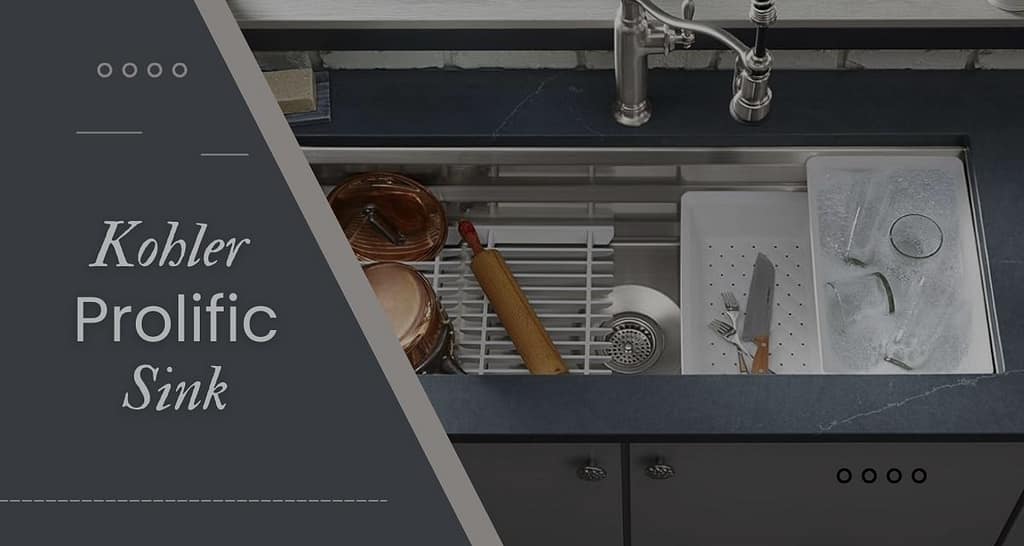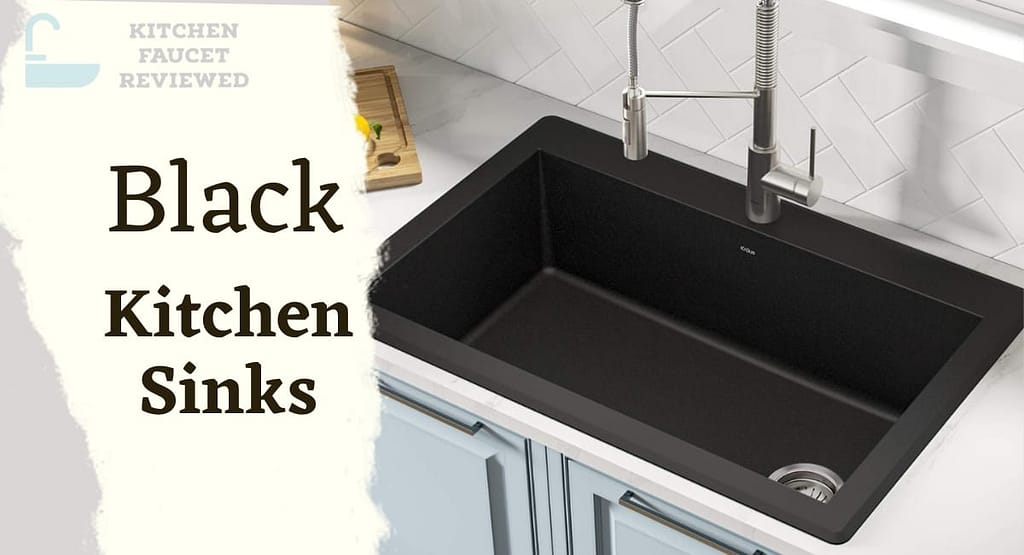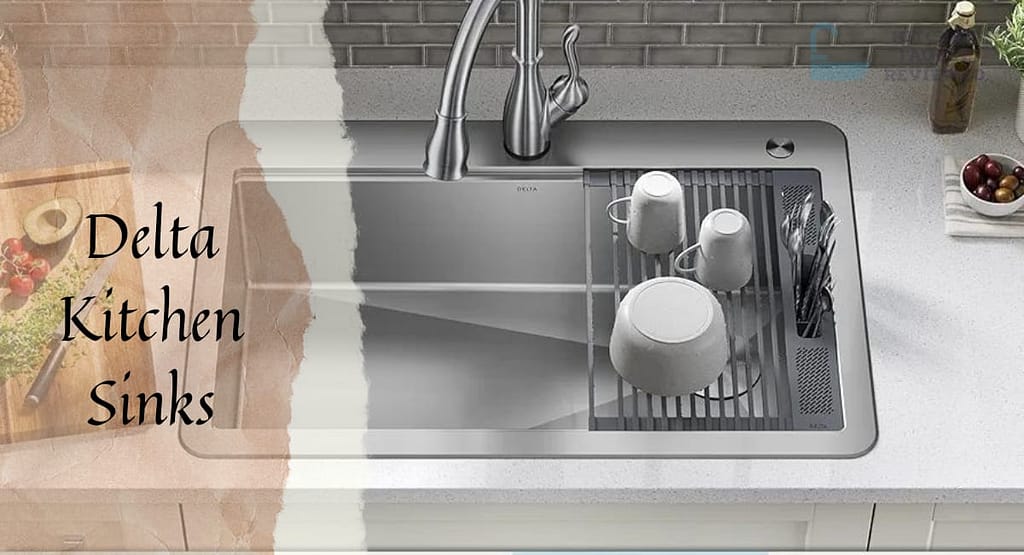Are you planning a kitchen renovation in 2025 and wondering what type of sink to choose? So you have landed the right place. In this blog, we’ve compiled a comprehensive guide to the 8 types of kitchen sinks you should know in 2025. From classic stainless steel to trendy composite materials, we’ve got you covered. So, let’s dive in and find the perfect sink to suit your style and needs!
There are several types of kitchen sinks available on the market, each with its own unique features, advantages, and disadvantages. Here are some of the most common types:
8 Types of Kitchen Sinks You Should Know
1: Undermount sinks
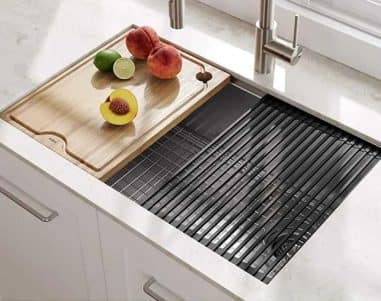
Undermount sinks are a popular choice for homeowners looking for a modern and elegant design in their kitchens or bathrooms. As the name suggests, undermount sinks are installed underneath the countertop, creating a seamless appearance that is both stylish and functional.
One of the main advantages of undermount sinks is their ease of cleaning and maintenance. Because there are no edges or rims to trap dirt and grime, these sinks are much easier to keep clean than traditional top-mounted sinks. This also makes them a great choice for busy households or commercial kitchens where hygiene is a top priority.
Another benefit of undermount sinks is their sleek and minimalist look. By hiding the sink rim beneath the countertop, the focus is on the clean lines of the countertop itself, creating an uncluttered and visually appealing space. This design also allows for greater flexibility in choosing materials for the countertop, as undermount sinks can be installed with a wide range of materials, from granite and marble to stainless steel and concrete.
However, one potential drawback of undermount sinks is their installation cost. Because they require professional installation and may require additional support underneath the countertop, undermount sinks can be more expensive to install than traditional top-mounted sinks. Additionally, because they are installed beneath the countertop, any leaks or damage to the sink or plumbing may be harder to detect and repair.
Despite these potential drawbacks, undermount sinks like Delta sinks remain a popular choice for homeowners and designers looking for a sleek and functional design. Whether you’re renovating your kitchen or bathroom, an undermount sink can be an excellent choice for creating a clean, modern look that is both practical and stylish.
2: Topmount sinks
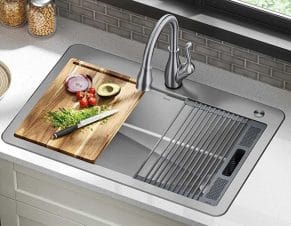
Topmount sinks, also known as drop-in sinks or self-rimming sinks, are a type of sink that sits on top of the countertop. They are the most common type of sink used in homes and commercial settings, and are available in a wide range of materials, sizes, and styles.
One of the main advantages of topmount sinks is their ease of installation. Because they sit on top of the countertop, they do not require any special installation methods or equipment. They simply need to be positioned in the cutout on the countertop and secured in place with clips or adhesive. This makes them an attractive option for DIY projects and those on a budget.
Topmount sinks are also typically less expensive than their undermount counterparts. This is because they require less labor and material to manufacture, and are generally easier to transport and handle. Additionally, their installation process is simpler and requires fewer specialized tools and skills.
In terms of design, topmount sinks are available in a wide range of materials and styles. Stainless steel is a popular choice for its durability and affordability, while porcelain, composite, and stone materials offer a more stylish and luxurious look. Topmount sinks can also be found in a variety of sizes and shapes, including single and double-bowl options.
One of the downsides of topmount sinks is that they can be harder to clean than undermount sinks. Because they sit on top of the countertop, dirt and debris can collect around the edges and in the gap between the sink and the countertop. This can make them more difficult to keep clean and sanitary, particularly in high-use areas like kitchens and bathrooms.
Overall, topmount sinks are a practical and cost-effective choice for those looking for a basic sink option that is easy to install and maintain. While they may not offer the same sleek and seamless look as undermount sinks, they are a versatile and durable choice that can be customized to fit any style or budget.
3: Farmhouse sinks
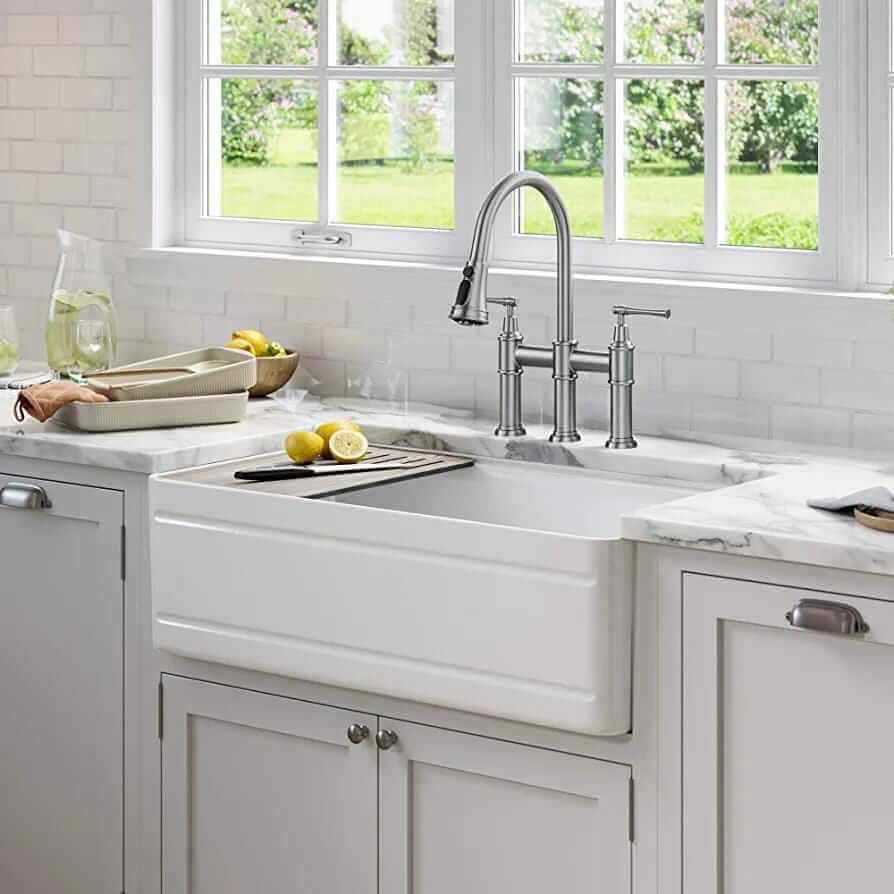
Farmhouse sinks, also known as apron-front sinks, are a popular style of sink that adds a rustic charm and unique character to any kitchen. These sinks are recognized for their large front panel that extends past the countertop, offering a unique design element that differentiates them from traditional sinks.
The front panel, or apron, of the sink is typically 7 to 10 inches in height and is visible even when the cabinets are closed, making it a statement piece in any kitchen. Farmhouse sinks are available in a variety of materials, but the most common ones include fireclay and cast iron.
Fireclay farmhouse sinks are crafted from a combination of clay and glaze, resulting in a sink that is durable and long-lasting. They are resistant to chipping, staining, and scratching, making them a practical choice for busy kitchens. Additionally, the glossy finish of fireclay sinks makes them easy to clean and maintain.
Cast iron farmhouse sinks are made from solid cast iron and coated with a layer of enamel. The enamel not only gives the sink a sleek, polished appearance but also protects it from damage caused by water, chemicals, and heat. Cast iron farmhouse sinks are available in a variety of colors, allowing homeowners to choose the one that best complements their kitchen decor.
Apart from their unique design, farmhouse sinks are also popular because of their functionality. They offer a deep basin that allows for larger items like pots and pans to be easily cleaned. Additionally, the apron-front design allows for less strain on the back and neck while washing dishes or performing other kitchen tasks, as the user can stand closer to the sink without having to lean over the countertop.
Installation of a farmhouse sink requires additional support compared to a traditional sink. As the sink’s front panel extends past the edge of the countertop, the cabinets below the sink need to be adjusted to accommodate the sink’s weight. This usually involves reinforcing the countertop with additional support beams and customizing the cabinetry to fit the sink’s dimensions.
4: Stainless steel sinks
Stainless steel sinks are a highly popular choice for kitchen sinks due to their durability and easy maintenance. They are made of a material that is highly resistant to corrosion, rust, and staining, which makes them ideal for a kitchen environment where water and moisture are frequently present.
One of the biggest advantages of stainless steel sinks is their durability. They are extremely resistant to scratches, chips, and dents, and can withstand high temperatures without warping or melting. This makes them ideal for heavy use, such as in a busy restaurant kitchen or a large family home.
Another advantage of stainless steel sinks is their ease of maintenance. They are incredibly easy to clean and do not require any special cleaning products or techniques. Simply wiping down the sink with a damp cloth or sponge is usually sufficient to remove any food particles, grease, or stains.
Stainless steel sinks are also highly versatile in terms of design. They come in a wide range of styles and sizes, including undermount, top-mount, and farmhouse styles. They can be customized to fit the exact dimensions of a kitchen, and can be paired with a variety of faucet and accessory options.
One of the key benefits of stainless steel sinks is their affordability. They are generally less expensive than other materials such as granite, quartz, or cast iron. This makes them a great option for homeowners who want a high-quality, durable sink without breaking the bank.
When shopping for a stainless steel sink, it’s important to consider the gauge of the steel. The gauge refers to the thickness of the steel, with lower numbers indicating a thicker steel. Thicker steel is generally more durable and less likely to dent or scratch. It’s also important to choose a sink with a sound-deadening feature, which helps to reduce noise from water and dishes.
In summary, stainless steel sinks are a highly durable, easy-to-maintain, versatile, and affordable option for any kitchen. With a variety of styles and sizes available, they can be customized to fit any kitchen design and are sure to provide years of use and enjoyment.
5: Cast Iron Sinks
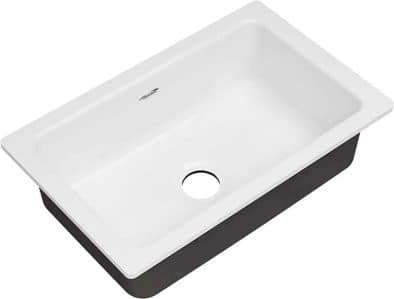
Cast iron sinks are a popular choice for many homeowners due to their durability and classic look. These sinks are made from molten iron that is poured into a mold, which is then smoothed and coated with a layer of enamel. The enamel finish not only provides an attractive appearance, but also helps to protect the iron from damage.
One of the main benefits of cast iron sinks is their durability. These sinks are incredibly heavy, and their weight can make them resistant to cracks and other types of damage. Additionally, the enamel coating can help to prevent scratches and stains, making cast iron sinks a good choice for high-traffic kitchens or bathrooms.
Cast iron sinks are available in a wide range of colors, from traditional white or black to more vibrant shades like red or blue. This makes it easy to find a sink that matches your existing decor or adds a pop of color to your space.
Despite their durability, cast iron sinks can be prone to chipping or cracking over time. This can be caused by a variety of factors, including heavy use, exposure to extreme temperatures, or accidental impact. However, if properly cared for, a cast iron sink can last for many years without showing signs of wear and tear.
To keep your cast iron sink in good condition, it’s important to clean it regularly using a mild detergent and a soft sponge or cloth. Avoid using abrasive cleaners or scouring pads, as these can scratch the enamel surface. Additionally, be sure to avoid exposing your sink to extreme temperatures or heavy impact, as this can cause it to crack or chip.
Overall, cast iron sinks are a great choice for homeowners who want a durable and attractive sink that can stand up to heavy use. Whether you’re renovating your kitchen or bathroom, a cast iron sink can provide the perfect combination of style and functionality.
6: Composite sinks
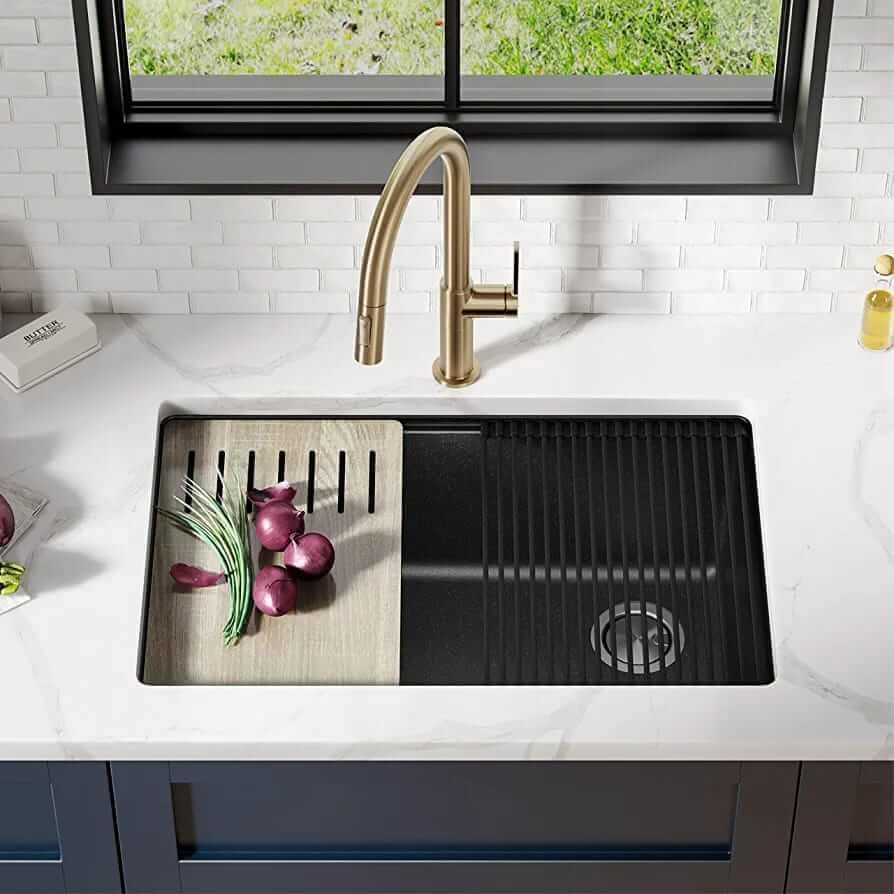
Composite sinks, as the name suggests, are made from a blend of materials that are specifically chosen for their durability, strength, and aesthetic appeal. The two most common materials used in composite sinks are granite and quartz, which are mixed with a synthetic resin binder to create a tough and resilient material. This material is considered as an ideal choice for kitchen or bathroom sinks
One of the biggest advantages of composite sinks is their durability. Unlike other sink materials, such as stainless steel or porcelain, composite sinks are highly resistant to scratches, chips, and dents. This makes them ideal for use in high-traffic areas where the sink may be subjected to a lot of wear and tear.
Another advantage of composite sinks is their versatility in terms of style and color. Because they are made from a blend of materials, composite sinks can be produced in a wide range of colors and styles, from sleek and modern to rustic and traditional. This makes them a popular choice for homeowners and designers who want to create a specific look or feel in their kitchen or bathroom.
However, composite sinks can also be more expensive than other sink materials, such as stainless steel or porcelain. This is because the manufacturing process for composite sinks is more complex and involves more materials. Additionally, the resin binder used in composite sinks is often more expensive than other sink materials.
Despite their higher cost, many homeowners and designers choose composite sinks for their durability, versatility, and aesthetic appeal. If you are considering a composite sink for your kitchen or bathroom, it is important to choose a reputable manufacturer and installer to ensure that the sink is properly installed and maintained over time. With proper care, a composite sink can last for many years and provide you with a beautiful and functional addition to your home.
7: Copper sinks
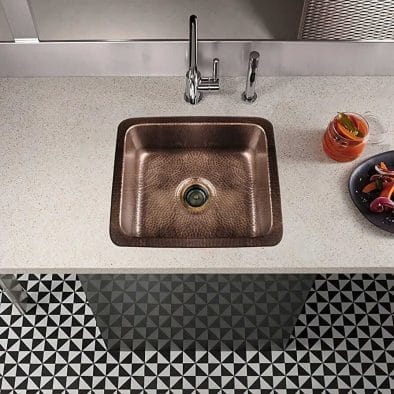
Copper sinks have become an increasingly popular choice for homeowners looking to add a touch of elegance and character to their kitchen. One of the main advantages of copper sinks is their ability to create a warm and inviting atmosphere in any space. With their natural reddish-brown hue, copper sinks can add a rustic charm to any kitchen decor, making them an excellent option for those who want to create a cozy and inviting environment.
In addition to their aesthetic appeal, copper sinks are also extremely durable and long-lasting. Unlike other sink materials, such as stainless steel or porcelain, copper is a sturdy and hard-wearing metal that can withstand daily use without showing signs of wear and tear. Additionally, copper has natural antimicrobial properties, which means that it can help to prevent the growth of bacteria and other harmful microorganisms.
However, despite their durability, copper sinks can be prone to scratching if not properly maintained. Over time, copper sinks can also develop a patina or tarnish, which can affect their appearance. To prevent this, it is important to clean copper sinks regularly using a mild soap and water solution, and to avoid using abrasive cleaners or materials that could scratch the surface.
Despite the potential maintenance required, the unique and stylish look of copper sinks make them a great option for those who want to add a touch of warmth and character to their kitchen. Whether you’re looking to create a modern, minimalist look or a more traditional, rustic feel, a copper sink can be an excellent choice that will help to elevate the overall style and aesthetic of your kitchen.
8: Ceramic sinks
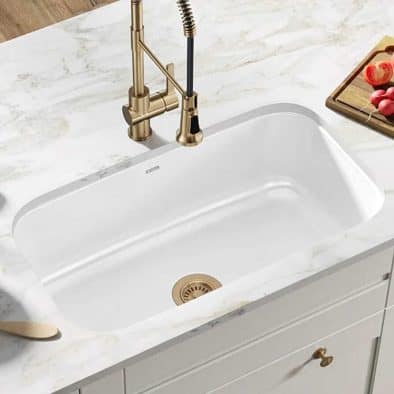
Ceramic sinks are a popular choice for both kitchens and bathrooms due to their classic and elegant appearance. They are typically made from porcelain or fireclay, which are both highly durable materials that can withstand daily use and wear.
One of the advantages of ceramic sinks is that they are easy to clean and maintain. Porcelain and fireclay are both non-porous materials, which means that they do not absorb stains or odors, making them highly resistant to dirt and grime buildup. Additionally, ceramic sinks can be easily wiped down with a damp cloth or sponge, making them ideal for busy households.
However, it is important to note that ceramic sinks can be more prone to chipping or cracking than other materials such as stainless steel or granite. This is because porcelain and fireclay can be brittle and less flexible than other materials. Therefore, it is recommended to avoid dropping heavy objects or using abrasive cleaners that can scratch or damage the surface of the sink.
Overall, ceramic sinks are a great choice for those who want a traditional and timeless look for their kitchen or bathroom. They known as their durable, easy to clean, and can bring a touch of elegance and sophistication to any space.
Our Verdict
Choosing the right kitchen sink for your home depends on your personal style, budget, and needs. Each type of sink has its own unique advantages and disadvantages that should be carefully considered before making a final decision. Undermount sinks provide a sleek and modern look, but can be more expensive to install. Topmount sinks are the most common and are generally more affordable and easier to install.
Farmhouse sinks offer a traditional, country-style look and are often made of durable materials like fireclay or cast iron. Stainless steel sinks are a popular choice due to their durability and easy maintenance. Cast iron sinks are heavy and durable, but can be prone to chipping or cracking over time. Composite sinks are durable and come in a variety of colors and styles, but can be more expensive. Copper sinks offer a unique and stylish option with natural antimicrobial properties, but require regular maintenance to prevent tarnishing.
Ceramic sinks provide a classic, traditional look but may be more prone to chipping or cracking. Overall, it’s important to carefully consider your options and choose a sink that not only fits your personal style but also meets your functional needs and budget.

